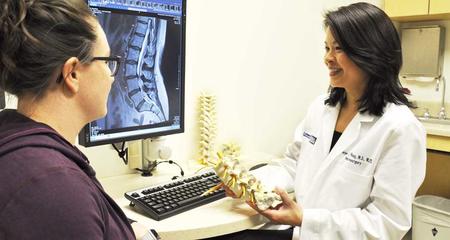There is no one-size-fits-all answer to spasticity. The most effective treatment plans are customized to your symptoms and lifestyle. The Comprehensive Spasticity Management Program offers a full range of treatment options.
Skilled Therapy
Physical therapists, occupational therapists and speech therapists offer valuable expertise to patients of the Comprehensive Spasticity Management Program. They help patients maximize movement, plan adaptations and coordinate care with the rest of the treatment team. They also provide a variety of treatments, including:
- Electrical stimulation. Small, safe bursts of electrical energy can be applied to strengthen a weaker muscle in order to minimize the effect of a spastic muscle. Electrical stimulation may also help some patients improve motor control.
- Partial bodyweight supported treadmill training. Using a sling to support the body, patients who are unable to bear weight can practice walking on a treadmill.
- Gait analysis. Therapists carefully monitor and assess patients’ walking movements to determine what interventions and exercises may be most helpful.
- Aquatic therapy. Water helps support the body and allows patients to move more freely through a number of appropriate stretching and strengthening exercises.
Exercise and Body Support
Special exercises can loosen tight muscles, maintain range of motion and improve movement. Splints, casts and braces can be used to hold spastic extremities in comfortable positions. Our specially trained therapists also use innovative treatments such as electrical muscle stimulation, robotic arm therapy and partial bodyweight supported treadmill training. Therapists tailor stretching and exercise plans to individual patients’ needs, and teach the movements to patients and family members. Stretching and strengthening exercises are most effective when done on a daily basis.
Often, a combination of exercise and support is recommended. Exercises are used to improve positioning, and splints, casts or braces are used to maintain the new, more functional position.
Oral Medications
A variety of oral medications can help control spasticity. Some relax overactive muscles. Others interrupt the nerve signals that travel from the brain or spinal cord to the affected muscles, while others interrupt the nerve signals that travel from the brain or spinal cord to the affected muscles. Your doctor will work with you to determine which medication (or medications) might be most helpful. It may take some time to find the most effective combination of medications and other treatments, but your health care team will listen to you and adjust your treatment regimen as needed to give you the best possible outcome.
Temporary Nerve Blocks
Local anesthetics can be used to temporarily block the nerve signals to certain muscles on a short-term basis in order to relax them, improve spasticity symptoms and determine if longer lasting treatments are appropriate.
Neurotoxin Injections
Neurotoxin injections are medications that can be injected directly into spastic muscles and provide between two and six months of reduced spasticity and pain, with potential for improved motor control.
Intrathecal Baclofen (ITB) Pump Therapy
Baclofen is a medication that relaxes muscles and reduces muscle spasms. When delivered by an implantable pump, baclofen can help patients experience long-term spasticity control with minimal side effects.
Our baclofen pump program is the largest, most experienced program in the state. Our spasticity management experts can help you determine if a baclofen pump is a good alternative for you. If it is, they’ll explain the procedure to you and tailor your dosage to provide maximum movement and control using minimal medication.
What does the ITB pump therapy process entail?
There are four stages to the ITB pump therapy process:
- A consultation visit to discuss your condition and goals, the impact of spasticity, previous treatments and what you should expect in the short and long term if ITB therapy is chosen
- A test injection, an ITB trial, is done to see if ITB therapy will work for you
- After the ITB test injection, your case is reviewed by our team to decide if you’re a good surgical candidate.
- If the team feels that you’re a candidate for surgery, a meeting is scheduled with our neurosurgery team.
- Surgery to implant the ITB pump into your body
- After your surgery, you’ll have regularly scheduled appointments to adjust and refill your ITB pump.
Orthopaedic Surgery
Specialized surgical procedures that elongate or reposition tendons to increase range of motion may be an option for some individuals.
Clinical Trials
Because our Comprehensive Spasticity Management program is part of an academic medical center, we are able to offer our patients access to new and promising treatments through clinical trials.
Virtual Visits Are Available
Safe and convenient virtual visits by video let you get the care you need via a mobile device, tablet or computer wherever you are. We'll assess your condition and develop a treatment plan right away. To schedule a virtual visit, call 414-777-7700.
More to Explore





